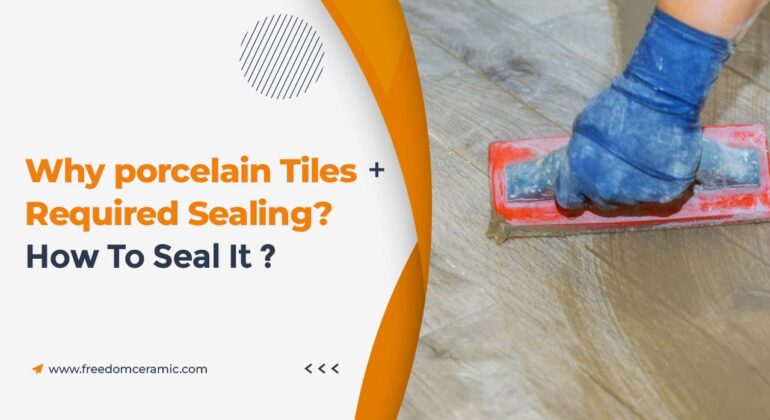Before installing fresh porcelain tiles, consider if they need to be sealed and which treatment is appropriate to be used. Sealing tiles and grout lower porosity and preserves the tiles’ surfaces, making them more resistant to dust, spillage, discoloration, and normal wear. This brings us to the question, “How to seal porcelain tiles?”
Before we get to the porcelain tiles sealing process porcelain tiles and grout that have been sealed will last relatively for an elongated period of time, feel fantastic, and be simpler to maintain. Grout is permeable by nature and may stain quickly; as a consequence, all grout must be protected when this has had sufficient time to set correctly. But, not every tile must be coated or sealed and you must consider that before going for a sealing treatment.
Why is it required?
Fully vitrified or polished porcelain tiles, the most common type of porcelain tile, are non-porous and do not require sealing. However, you may apply a nano-upper coating sealer to change the color or create a shine.
Because of its surface, porcelain tiles that are installed in the exterior environment might get discolored or take up dust and hence should be sealed. You also could treat the porcelain tiles to keep fungal growth at bay. One of the best way to seal porcelain tiles is using a nano top-coat protector, which can intensify colors and produce a shine on your tiles.
Following the installation of tiles, it is not rare for customers to observe a loss of tone or a scrubbed and gritty look. This problem may be solved by using a sealant that helps in retaining the overall luster of the porcelain tiles. Even Fully vitrified non-permeable tiles are only coated with a nano sealant.
If porcelain specifies a ‘nano sealed,’ it will not need to be sealed during placement. Nevertheless, if you want to guarantee that the tiles and grout effectively resist water and oil while also keeping them looking spotless for an extended period of time, a layer of sealer may be placed following grouting. It is not essential to seal any glossy tiles or superb quality unpolished porcelain tiles; nevertheless, it is advised to use a grout sealer if you do want to preserve the grouting and make regular maintenance a breeze.
Steps to Seal Porcelain Tiles
The basic steps to seal porcelain tiles involves the following:
- Before you seal, thoroughly clean the whole tiled area. It is one of the essential steps to seal porcelain tiles.
- The next step in the porcelain tiles sealing process is the first coat of sealant. The first layer of sealant should be applied after ensuring that the surface is absolutely clean. Apply one thin layer of sealant. It should be done manually or with a clean microfiber pad and microfiber cloth. You must only administer a single thin application of the solution, thoroughly dampening both the tile and the grout.
- Following the above step you may now go for the grouting phase to seal the gaps between porcelain tiles. Grout the tiles and allow them to dry completely. Follow the work instructions provided by the manufacturer on how long to keep the grout on the tiling.
- Put the final layer of sealer, making sure it is uniformly distributed and allowed to dry.
The kind of tile sealer required will depend on the material composition of the tiles being coated. The requirement of quantity will vary based on the sort of tile getting treated as well as the area of the floor, as certain tiles retain more than others.
It is critical to apply the proper kind of tile sealant for the sort of porcelain tiles being installed since the incorrect sealant might permanently harm the tile.
For More Information Contact Us @ export@freedomceramic.com / +91 97236 40507






